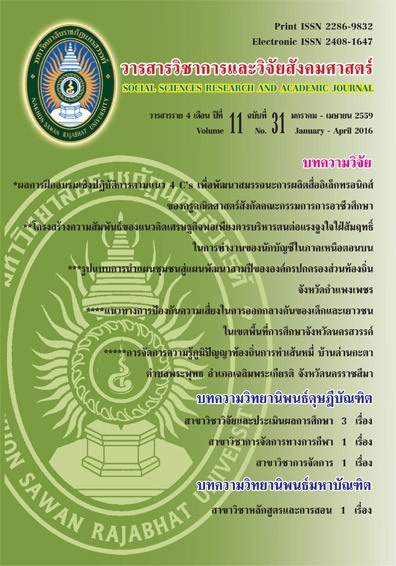การจัดการความรู้ภูมิปัญญาท้องถิ่นการทำเส้นหมี่ บ้านด่านกะตา ตำบลพระพุทธ อำเภอเฉลิมพระเกียรติ จังหวัดนครราชสีมา; Knowledge Management of Local Wisdom in Rice Noodle, Baan Dan Kata, Pra Put Sub-District, Chaloem Phra Kiat District, Nakhon Ratchasima
Main Article Content
Abstract
บทคัดย่อ
การศึกษาครั้งนี้มีวัตถุประสงค์ 1) เพื่อศึกษาบริบทการทำเส้นหมี่ บ้านด่านกะตา ตำบลพระพุทธ อำเภอเฉลิมพระเกียรติ จังหวัดนครราชสีมา 2) เพื่อศึกษาการผลิตและการถ่ายทอดความรู้ ภูมิปัญญาท้องถิ่นการทำ เส้นหมี่ บ้านด่านกะตา ตำบลพระพุทธ อำเภอเฉลิมพระเกียรติ จังหวัดนครราชสีมา 3) เพื่อหาแนวทางการจัดการความรู้ เพื่อยกระดับภูมิปัญญาท้องถิ่นการทำส้นหมี่ บ้านด่านกะตา ตำบลพระพุทธ อำเภอเฉลิมพระเกียรติ จังหวัดนครราชสีมา กลุ่มเป้าหมาย คือ ผู้รู้และผู้ผลิตเส้นหมี่ ผู้นำชุมชน องค์กรปกครอง ส่วนท้องถิ่น ตัวแทนหน่วยงานที่เกี่ยวข้องและประชาชนบ้านด่านกะตา ตำบลพระพุทธ อำเภอเฉลิมพระเกียรติ จังหวัดนครราชสีมา โดยแบ่งตามขั้นตอนการจัดการความรู้ เป็น 1) การค้นหาความรู้ 2) การรวบรวมความรู้ 3) การถ่ายทอดความรู้ 4) การประยุกต์ใช้ความรู้ เครื่องมือที่ใช้ในการวิจัยคือแบบสัมภาษณ์เชิงลึก (Indepth Interview) การสนทนากลุ่ม (Focused Group Discussion) การสังเกตการณ์แบบมีส่วนร่วมและไม่มีส่วนร่วม การวิเคราะห์ข้อมูล ส่วนใหญ่ข้อมูลที่นํามาวิเคราะห์ เป็นข้อความลักษณะบรรยาย (Descriptive) ที่ได้จากการสังเกต สัมภาษณ์ และจดบันทึกนำมาวิเคราะห์ข้อมูลแบบสร้างข้อสรุป
ผลการวิจัยพบว่า
1. บริบทการทำเส้นหมี่ ชุมชนบ้านด่านกะตา เริ่มต้นจากนางบุญธรรม จอนจอหอ ซึ่งได้รับการสืบทอดการทำเส้นหมี่จากบรรพบุรุษเพื่อเป็นรายได้เสริมหลังจากการทำนา เริ่มก่อตั้งกลุ่มเส้นหมี่โดยการส่งเสริมจากหน่วยงานภาครัฐแต่ก็ต้องยุติลงเนื่องจากปัญหาการผลิตเส้นหมี่ไม่ได้คุณภาพ เพราะความเร่งรีบเมื่อมียอดการสั่งซื้อจำนวนมาก และมีปัญหาด้านการตลาด
2. การผลิตและการถ่ายทอดความรู้ ภูมิปัญญาท้องถิ่นการทำเส้นหมี่ บ้านด่านกะตา พบว่า ยังไม่มีการบันทึกเป็นลายลักษณ์อักษร ใช้การถ่ายทอดโดยการบอกเล่า และเน้นการปฏิบัติตาม อาศัยกระบวนการถ่ายทอดองค์ความรู้โดยบุคคลและมีศูนย์การเรียนรู้ชุมชน และมีการศึกษาดูงาน เพื่อนำความรู้มาพัฒนาผลิตภัณฑ์ของตนเอง
3. แนวทางการจัดการความรู้ เพื่อยกระดับภูมิปัญญาท้องถิ่นการทำเส้นหมี่บ้านด่านกะตา ด้วยการบูรณาการกับการเรียนการสอนในสาระการเรียนรู้การงานอาชีพและเทคโนโลยี โดยการสาธิตการผลิตเส้นหมี่และมีสื่อวิดีทัศน์ประกอบการเรียนการสอน เพื่อให้นักเรียนที่เป็นเยาวชนในชุมชนเกิดจิตสำนึกและเห็นคุณค่าต่อภูมิปัญญาท้องถิ่นเพื่อเป็นการอนุรักษ์ภูมิปัญญาให้คงอยู่สืบไป
Abstract
This study aims: 1) to study the sen-mee rice noodle-making, 2) to study knowledge production and knowledge transmission of rice noodle-making, and 3) to find the knowledge management’s influences of rice noodle-making in Baan Dan Kata, Pra Put Sub-district, Chaloem Phra Kiat District, Nakhon Ratchasima. The research participants were sen-mee rice noodle manufacturers, local government community leaders, agency’s representatives and villagers of Baan Dan Kata, Pra Put Sub-district, Chaloem Phra Kiat District, Nakhon Ratchasima. They were divided by the process of knowledge management into 4 steps: 1) Knowledge acquisition, 2) External collection of knowledge, 3) Transferring knowledge, and
4) Application of knowledge. Correspondingly, the tools used were indepth interview, focused group discussion, participant and non-participant observations. For data analysis, most of the data were analyzed from a message describing the characteristics (Descriptive) derived from observation, interview and record of the data analysis conclusion.
The results showed that:
1. Mrs. Boontam Jonjarho was the innovator of the sen-mee rice noodle-making in Baan Dan Kata, which her local wisdom has been passed down from her ancestors, so that she may gain her extra income after farming. In 1985,
Sen-mee rice noodle-making was established by a group and promoted by government agencies; however, it was lack of a good making’s quality. Thus, the production was stopped.
2. In producing and transferring knowledge which was the local wisdom of rice noodle-making in Baan Dan Kata, no written record was found, only the retelling from generation to generation. The knowledge was transferred by individuals as a source of knowledge or the compliance process of family members, such as by grandparents to parents. The noodles making was taught once at the community learning center. Besides, manufacturers had a chance to observe from other villages nearby, they learned to develop their products.
3. Knowledge management approach in improving the local wisdom of rice noodle-making, in Baan Dan Kata, has integrated with the teaching and training of career and technology learning. With rice noodle-making demonstration, educational material and others useful media are used, so that young learners in community can gain their awareness and appreciation of local knowledge and nurture the wisdom to remain.


